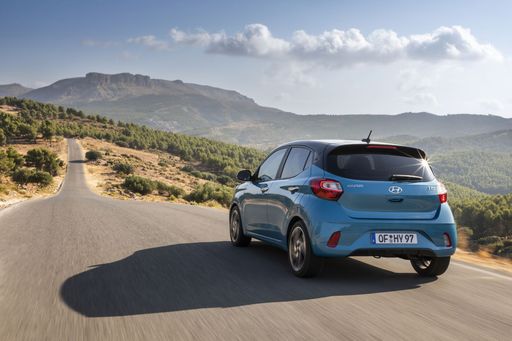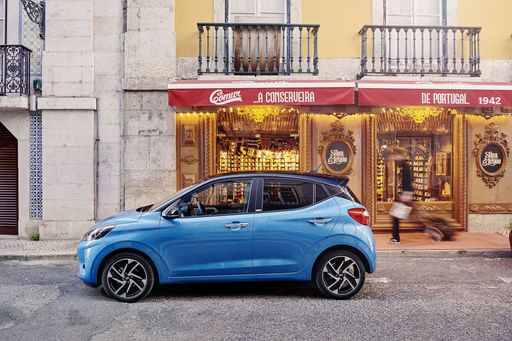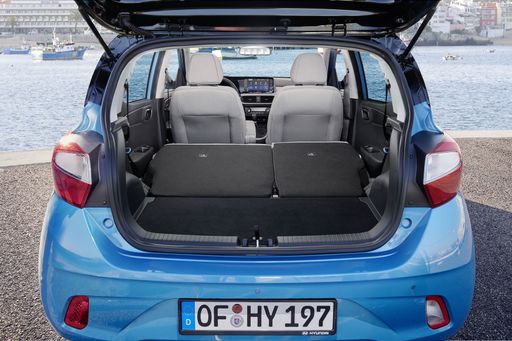Alfa Romeo Junior vs Hyundai i10 – Differences & prices compared
Both models have their strengths – but which one suits you more?
Compare performance, efficiency, price and space directly: Alfa Romeo Junior or Hyundai i10?
Costs and Efficiency:
When it comes to price and running costs, the biggest differences usually appear. This is often where you see which car fits your budget better in the long run.
Hyundai i10 has a clearly advantage in terms of price – it starts at 14600 £, while the Alfa Romeo Junior costs 25700 £. That’s a price difference of around 11109 £.
Fuel consumption also shows a difference: Alfa Romeo Junior manages with 4.80 L and is therefore hardly perceptible more efficient than the Hyundai i10 with 4.90 L. The difference is about 0.10 L per 100 km.
Engine and Performance:
Power, torque and acceleration are the classic benchmarks for car enthusiasts – and here, some clear differences start to show.
When it comes to engine power, the Alfa Romeo Junior has a clearly edge – offering 280 HP compared to 90 HP. That’s roughly 190 HP more horsepower.
In acceleration from 0 to 100 km/h, the Alfa Romeo Junior is significantly quicker – completing the sprint in 5.90 s, while the Hyundai i10 takes 11.40 s. That’s about 5.50 s faster.
In terms of top speed, the Alfa Romeo Junior performs slightly better – reaching 206 km/h, while the Hyundai i10 tops out at 175 km/h. The difference is around 31 km/h.
There’s also a difference in torque: Alfa Romeo Junior pulls significantly stronger with 345 Nm compared to 172 Nm. That’s about 173 Nm difference.
Space and Everyday Use:
Whether family car or daily driver – which one offers more room, flexibility and comfort?
Both vehicles offer seating for 5 people.
In curb weight, Hyundai i10 is noticeable lighter – 996 kg compared to 1380 kg. The difference is around 384 kg.
In terms of boot space, the Alfa Romeo Junior offers clearly perceptible more room – 415 L compared to 252 L. That’s a difference of about 163 L.
In maximum load capacity, the Alfa Romeo Junior performs a bit better – up to 1280 L, which is about 230 L more than the Hyundai i10.
When it comes to payload, Hyundai i10 barely noticeable takes the win – 423 kg compared to 420 kg. That’s a difference of about 3 kg.
Who wins the race?
The Alfa Romeo Junior proves to be outperforms in nearly all aspects and therefore becomes our DriveDuel Champion!
Alfa Romeo Junior is the better all-rounder in this comparison.
 @ Alfa Romeo / Stellantis Media
@ Alfa Romeo / Stellantis Media
Alfa Romeo Junior
Alfa Romeo Junior
The Alfa Romeo Junior captures the essence of Italian design with its sleek lines and compact dimensions, making it an icon of elegance and performance. With a spirited driving experience and a charming retro aesthetic, it appeals to enthusiasts and casual drivers alike. This delightful car embodies the brand's rich heritage while remaining a fun and engaging option for those seeking a unique automotive experience.
details @ Alfa Romeo / Stellantis Media
@ Alfa Romeo / Stellantis Media
 @ Alfa Romeo / Stellantis Media
@ Alfa Romeo / Stellantis Media
 @ Alfa Romeo / Stellantis Media
@ Alfa Romeo / Stellantis Media
Hyundai i10
The Hyundai i10 impresses with its compact design, making it an ideal choice for navigating through busy urban environments. Its interior is surprisingly spacious, offering drivers and passengers comfort beyond what one might expect from a city car. The model combines efficiency and practicality, making it an attractive option for those seeking both economy and functionality in their daily commute.
details @ Hyundai Motor Company
@ Hyundai Motor Company
 @ Hyundai Motor Company
@ Hyundai Motor Company
 @ Hyundai Motor Company
@ Hyundai Motor Company
 @ Hyundai Motor Company
@ Hyundai Motor Company
 @ Hyundai Motor Company
@ Hyundai Motor Company
 @ Alfa Romeo / Stellantis Media
@ Alfa Romeo / Stellantis Media
|
 @ Hyundai Motor Company
@ Hyundai Motor Company
|
|
|
|
Costs and Consumption |
|
|---|---|
|
Price
25700 - 41600 £
|
Price
14600 - 19000 £
|
|
Consumption L/100km
4.8 - 5.4 L
|
Consumption L/100km
4.9 - 5.5 L
|
|
Consumption kWh/100km
15.1 - 17.5 kWh
|
Consumption kWh/100km
-
|
|
Electric Range
344 - 410 km
|
Electric Range
-
|
|
Battery Capacity
0.4 - 51 kWh
|
Battery Capacity
-
|
|
co2
0 - 119 g/km
|
co2
110 - 124 g/km
|
|
Fuel tank capacity
44 - 45 L
|
Fuel tank capacity
36 L
|
Dimensions and Body |
|
|---|---|
|
Body Type
SUV
|
Body Type
Hatchback
|
|
Seats
5
|
Seats
4 - 5
|
|
Doors
5
|
Doors
5
|
|
Curb weight
1380 - 1689 kg
|
Curb weight
996 - 1099 kg
|
|
Trunk capacity
340 - 415 L
|
Trunk capacity
252 L
|
|
Length
4173 mm
|
Length
3670 - 3675 mm
|
|
Width
1781 mm
|
Width
1680 mm
|
|
Height
1505 - 1538 mm
|
Height
1480 - 1483 mm
|
|
Max trunk capacity
1205 - 1280 L
|
Max trunk capacity
1050 L
|
|
Payload
390 - 420 kg
|
Payload
344 - 423 kg
|
Engine and Performance |
|
|---|---|
|
Engine Type
Electric, Petrol MHEV
|
Engine Type
Petrol
|
|
Transmission
Automatic
|
Transmission
Manuel, Automatic
|
|
Transmission Detail
Dual-Clutch Automatic, Reduction Gearbox
|
Transmission Detail
Manual Gearbox, Automated Manual
|
|
Drive Type
Front-Wheel Drive, All-Wheel Drive
|
Drive Type
Front-Wheel Drive
|
|
Power HP
136 - 280 HP
|
Power HP
63 - 90 HP
|
|
Acceleration 0-100km/h
5.9 - 9.1 s
|
Acceleration 0-100km/h
11.4 - 18.4 s
|
|
Max Speed
150 - 206 km/h
|
Max Speed
143 - 175 km/h
|
|
Torque
230 - 345 Nm
|
Torque
93 - 172 Nm
|
|
Number of Cylinders
3
|
Number of Cylinders
3 - 4
|
|
Power kW
100 - 207 kW
|
Power kW
46 - 66 kW
|
|
Engine capacity
1199 cm3
|
Engine capacity
998 - 1197 cm3
|
General |
|
|---|---|
|
Model Year
2024 - 2025
|
Model Year
2024
|
|
CO2 Efficiency Class
A, C, D
|
CO2 Efficiency Class
C, D
|
|
Brand
Alfa Romeo
|
Brand
Hyundai
|
What drive types are available for the Alfa Romeo Junior?
Available configurations include Front-Wheel Drive or All-Wheel Drive.
The prices and data displayed are estimates based on German list prices and may vary by country. This information is not legally binding.
